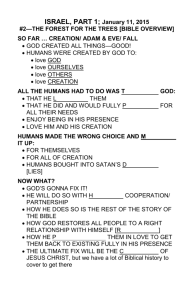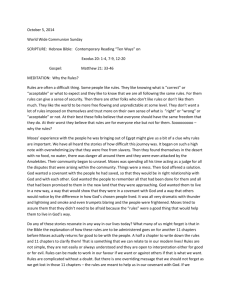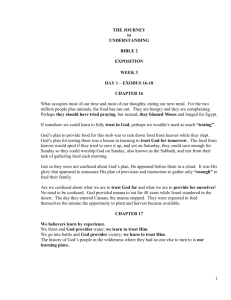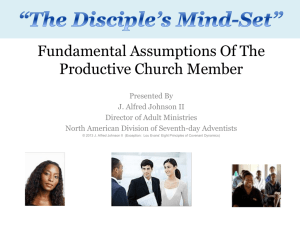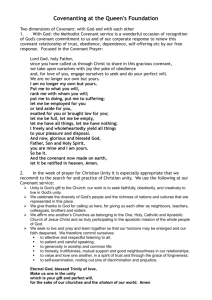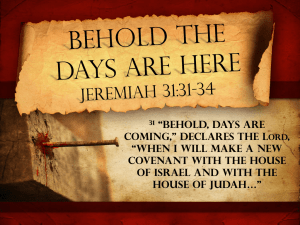Second Reading
advertisement
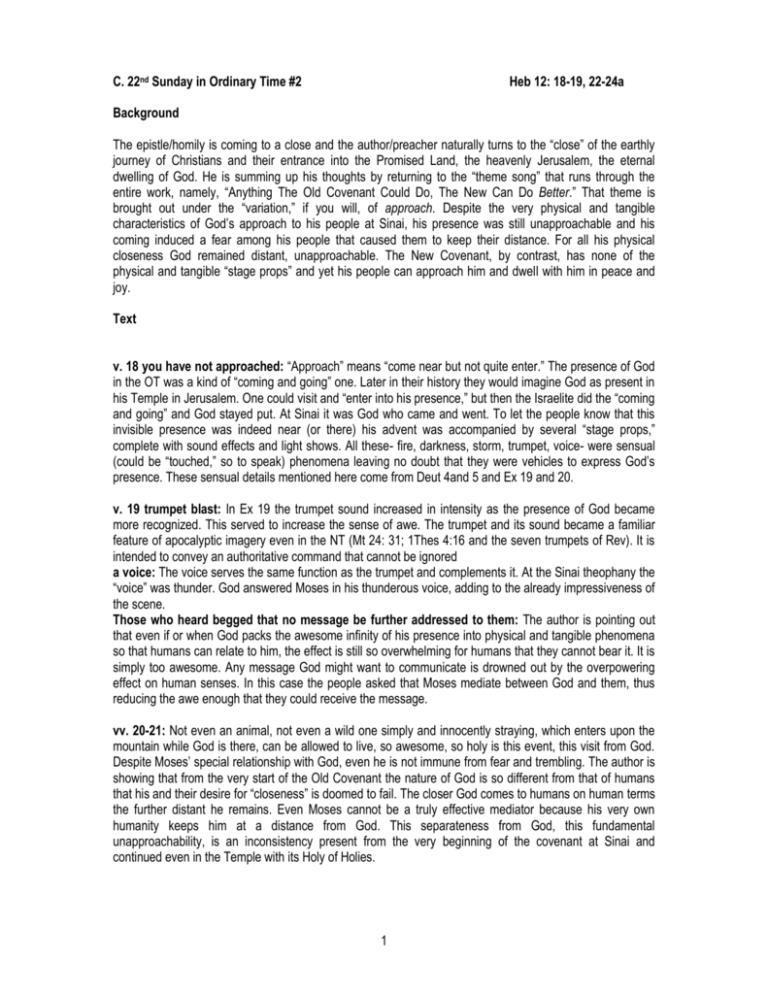
C. 22nd Sunday in Ordinary Time #2 Heb 12: 18-19, 22-24a Background The epistle/homily is coming to a close and the author/preacher naturally turns to the “close” of the earthly journey of Christians and their entrance into the Promised Land, the heavenly Jerusalem, the eternal dwelling of God. He is summing up his thoughts by returning to the “theme song” that runs through the entire work, namely, “Anything The Old Covenant Could Do, The New Can Do Better.” That theme is brought out under the “variation,” if you will, of approach. Despite the very physical and tangible characteristics of God’s approach to his people at Sinai, his presence was still unapproachable and his coming induced a fear among his people that caused them to keep their distance. For all his physical closeness God remained distant, unapproachable. The New Covenant, by contrast, has none of the physical and tangible “stage props” and yet his people can approach him and dwell with him in peace and joy. Text v. 18 you have not approached: “Approach” means “come near but not quite enter.” The presence of God in the OT was a kind of “coming and going” one. Later in their history they would imagine God as present in his Temple in Jerusalem. One could visit and “enter into his presence,” but then the Israelite did the “coming and going” and God stayed put. At Sinai it was God who came and went. To let the people know that this invisible presence was indeed near (or there) his advent was accompanied by several “stage props,” complete with sound effects and light shows. All these- fire, darkness, storm, trumpet, voice- were sensual (could be “touched,” so to speak) phenomena leaving no doubt that they were vehicles to express God’s presence. These sensual details mentioned here come from Deut 4and 5 and Ex 19 and 20. v. 19 trumpet blast: In Ex 19 the trumpet sound increased in intensity as the presence of God became more recognized. This served to increase the sense of awe. The trumpet and its sound became a familiar feature of apocalyptic imagery even in the NT (Mt 24: 31; 1Thes 4:16 and the seven trumpets of Rev). It is intended to convey an authoritative command that cannot be ignored a voice: The voice serves the same function as the trumpet and complements it. At the Sinai theophany the “voice” was thunder. God answered Moses in his thunderous voice, adding to the already impressiveness of the scene. Those who heard begged that no message be further addressed to them: The author is pointing out that even if or when God packs the awesome infinity of his presence into physical and tangible phenomena so that humans can relate to him, the effect is still so overwhelming for humans that they cannot bear it. It is simply too awesome. Any message God might want to communicate is drowned out by the overpowering effect on human senses. In this case the people asked that Moses mediate between God and them, thus reducing the awe enough that they could receive the message. vv. 20-21: Not even an animal, not even a wild one simply and innocently straying, which enters upon the mountain while God is there, can be allowed to live, so awesome, so holy is this event, this visit from God. Despite Moses’ special relationship with God, even he is not immune from fear and trembling. The author is showing that from the very start of the Old Covenant the nature of God is so different from that of humans that his and their desire for “closeness” is doomed to fail. The closer God comes to humans on human terms the further distant he remains. Even Moses cannot be a truly effective mediator because his very own humanity keeps him at a distance from God. This separateness from God, this fundamental unapproachability, is an inconsistency present from the very beginning of the covenant at Sinai and continued even in the Temple with its Holy of Holies. 1 v. 22 Now you have approached Mount Zion: The focus shifts to Christians. The mountain is not the earthly one of Sinai but the heavenly one, called here Zion after the earthly mount on which the Jerusalem Temple was built, the earthly dwelling of God. Now we are in heaven. Yet, for all the supposed and seeming physical distance of heaven from earth, the author wants to show that such, in fact, renders God much closer to us because of a new and more effective (a ”better” than Moses) mediator, Jesus Christ. Gone now is the dread and separation. The city of the living God, the heavenly Jerusalem: God might not “fit” very well into the earthly realities he created. His presence cannot be contained within any limits, but he is quite at home in his heavenly environment. Thus, in the final analysis, it is humans who must dwell with God in heaven rather than God dwelling with them on earth. For all its beauty and immensity, the earth, indeed the universe, is still too small and limited for God. So, God had so designed things and ordered his plan that we shall live with him. The failure, intrinsic failure, of the Old Covenant is now corrected. God is not only approachable now but can be enjoyed in “festal gathering.” No more fear and trembling, just joy. No more storm phenomena- shaking of the earth, fire, wind, etc.- just peace, the calm after the storm. v. 23 the assembly of the firstborn enrolled in heaven: On earthly terms there can be only one “firstborn” per family or assembly (the same word for “church”). In that light the firstborn would be Christ (Col 1:15). But looked at from another light, all are equally “firstborn” since all inherit the same kingdom riches. In 12: 16 Esau was mentioned as one who sold his birthright as firstborn for a single meal. Now, in the New Covenant, we are all at the same meal with the same status, thanks to Christ. God the judge of all: God is not only the one who condemns but also the one who examines, discriminates and, finally, separates. Only those deemed unjust will be separated from God’s presence. The spirits of the just made perfect: In v. 9 God was called the “Father of spirits.” Those “spirits” include human spirits, those who have become just by virtue of what Christ did for them. They are perfected or completed, perhaps not fully while on their earthly journey, but eventually when they reach the entrance of heaven. v. 24 and Jesus, the mediator of the new covenant: The focus shifts again. This time it shifts to the real center. It is through Jesus that all this is possible. Moses was human. Jesus was human. But Jesus was fully human and then some. He is also divine and, as such, he is able to be a mediator in a way Moses could not. He can stand between us and God, go between us and God. He can overcome the inherent obstacles to God. God can be approached because we walk behind Jesus who protects us from the overwhelming awe of God’s immensity and intensity. The Old and New Covenant cannot compare. They can only contrast and clash. The New is far superior to the old because it actually accomplishes what the old could only hope. 2 Reflection We cannot only sympathize with our OT ancestors, we can identify with them. There is still a very real sense in which we, like them, hope for the realization of the promises of God. But there is a real difference. Christ has accomplished what we hope for. We accept the fact that we will not fully experience and enjoy the benefits of living in God’s presence, uninterrupted by distractions, unchallenged by temptations, unfettered by sin and injustice, until we die to earth. But we also know, because we experience, some measure, a daily increasing measure, of that joy here and now, while still alive on earth. Like that of our spiritual predecessors, our hope is incomplete and future. Unlike that of our spiritual predecessors, our hope is realizable because it has been realized and accomplished in and by Christ. When we think that God cannot be contained on earth, let alone in any earthly phenomenon or conglomeration of phenomena, we are impressed by God’s wisdom in choosing a human being, Jesus, to be the fullest expression possible of his awesome being. Even though a human being is also inadequate to the task of fully reflecting God, only a human being could begin to authentically do so. Humans are God’s favorite and finest creation, made in his image and likeness. Upon reflection it only makes sense that he would become visible in this form. Yet, it also makes sense that he would not stay here on earth in merely human form. For all his finality, the presence of God incarnate was still a visit, a temporary event, like Sinai. He rose and returned in spirit form. He dwells now on earth within his people, physically invisible again. True, he becomes visible by our behavior now. We make Christ incarnate under the power of his spirit dwelling within us. But, true, nonetheless, all this is still to be completed. Thus we, like the Jews of old, hope. Which means we strive, need to progress and need to check our compass frequently to ensure we are moving in the right and forward direction. We need God’s word, guidance, Spirit to finish the race, trip, trek, however we wish to characterize it. So, we take delight that the New Covenant is superior to the Old, in a different class altogether. But we do so without giving offense to those still in the Old. We do not feel superior to them, only luckier. We have Christ. None of this is our doing. We take no credit and intend no offense when we give thanks for this great mediator. Because of him, God need no longer “come and go” and neither need we. Looking forward in hope to the day when we can be in his presence, fully aware of him, stimulates us to grow now in and toward that uninterrupted awareness of his presence. We would think it otherwise impossible if it were not for Christ who did it when he lived here on earth before his resurrection. He also told us we can do it to through him. “Through him” is, of course, the key difference. When we converse with God we do not converse as a single individual. We converse “through him, with him and in him.” That difference makes our conversations with God effective. They aren’t just stabs in the dark, hoping to connect, not knowing whether we have connected. No, our union with Christ assures us that we are getting through and that God is coming through to us. This connection is always there. True, we must turn it on, but it is always there, ready to happen. We need not go to a physical place or pick up a phone or connect via computer. By a simple mental decision and by virtue of our identification with and incorporation into Christ, i.e. living Baptism, we find ourselves in the presence of God and even more astounding, God ready and willing to converse and commune with us. On earth, it does not get any better than that. Indeed, it cannot get any better. And this is only the first stage of an eternal union and communion with God himself. 3 Key Notions 1. 2. 3. 4. 5. The old covenant teaches humans how to discern God’s heavenly presence in earthly phenomena. The old covenant teaches humans how distant God remained no matter how close he came. The new covenant teaches humans how to discern God’s presence within themselves. The new covenant teaches humans how close God remains no matter how distant he seems. God is distant and close, simultaneously transcendent and immanent. Food For Thought 1. Idolatry: Of course, God reveals himself through his creation, through the objects, phenomena, people and even plants and animals of creation. How else would we earthlings know the invisible God? The Jews were not the only people in the ancient world who experienced God through natural phenomena like lightning and thunder and fire or natural objects like mountains or holy people like Moses or the burning bush or the innocent lamb. God needs to become visible in some form or fashion if humans are not to miss his presence. The old covenant enshrines some of those events and revisited the shrines of those events either in their minds or physically (celebrating the great feasts of their faith, like Tabernacles, Passover and Pentecost either in Jerusalem or in their hearts wherever they were). But there is a twofold danger in discerning God in his creation. One is that we foolishly locate God in the particular object, phenomenon or event. In other words, we forget that the invisible God (now visible in some fashion) is also simultaneously indivisible, one, always one. God is totally and completely present always and everywhere. Were it not so there nothing else and no one else could be present anywhere or ever. He is the basis, the foundation, the ground of all being. Forgetting that, we can try to make the particular manifestation of God into God himself and such a mistake results in idolatry, worshipping the creature instead of its creator. Statues, icons, shrines, monuments, mountains, etc. all have their place and precisely because they do have a place (they are here and not there at some other place) they are limited. When this limitation is forgotten and the divine is located in a particular place, God (whom they are meant to reveal) becomes distant. This is true because we must inevitably become distant from these objects. We can’t stay in that one place where God revealed himself to us. We must travel around. Thus, humans began carrying around their icons and fetishes (like arks) in the vain attempt to experience the presence of the divine at all times. Only what they experienced was the absence, the distance of the divine, because the icons and statutes were dead things not living realities. While it is very human to set aside, set apart, certain objects and dedicate them to strictly religious use, it is also dangerous to do so, for we can easily forget that they should be reminders that all objects are holy in that they all reflect something of God. It is very human to set aside certain phenomena and events in a culture’s life and history (like national holidays and historical remembrances) and honor them for both education of the young and edification of all, but it is also dangerous, for we can easily forget that God is also present in every phenomenon and event. Unless the “special” objects, phenomena, events remind us of the potential sanctity of every moment of our lives, both individual and communal, idolatry sets in. Ironically, the very things intended to worship God end up making God distant and even absent from our experience. 2. True Worship: God so loved the world that he sent his only Son into the world to redeem it, i.e. to restore it to union with him. Only a human being, really a simultaneously human and divine being (although strictly speaking God is not a being, but being itself) could prevent humans from falling into the trap of idolatry, a trap of human making. Only the divine presence living at all times within a person, wherever the person goes and whatever experiences the person has, can prevent worshipping the creature instead of the creator. The creature is both visible to the human eye (sometime needing the aid of a microscope, however) and also divisible, capable of being reproduced and multiplied and incapable of being everywhere. God is invisible and indivisible. Only Christ can and does unite these polarities, these seeming contradictions, making true worship possible. 4
